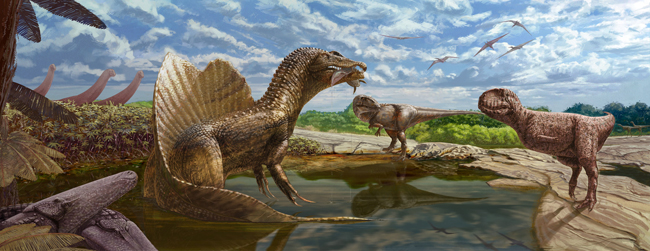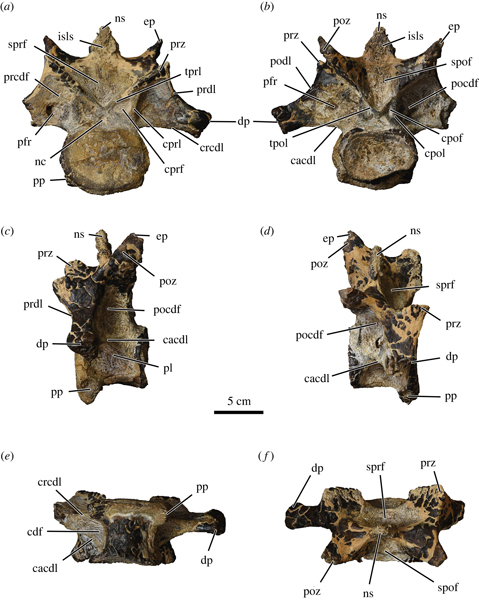Abelisaurids Lived Alongside Spinosaurus According to New Study
Last week, the discovery of the fossilised bones of a huge spinosaurid from the Isle of Wight was reported*. This giant theropod, with an estimated length of around ten metres, could be the biggest meat-eating dinosaur described from European fossils, but the largest theropod known to science is thought to be Spinosaurus aegyptiacus, which was first reported from the Bahariya Formation of Egypt.
Spinosaurus had plenty of company, several large theropods have been named and described from fossils from the Upper Cretaceous (Cenomanian), Bahariya Oasis, Western Desert of Egypt and a newly published paper confirms the presence of abelisaurids in this ancient ecosystem too.

Reconstruction of the palaeoecosystem of the Upper Cretaceous (Cenomanian) Bahariya Formation of the Bahariya Oasis, Western Desert of Egypt. A single neck bone proves the presence of abelisaurids in the ecosystem. Picture credit: Andrew McAfee, Carnegie Museum of Natural History.
Picture credit: Andrew McAfee, Carnegie Museum of Natural History
Cervical Vertebra Fossil Discovery
A 2016 expedition led by researchers from the Mansoura University Vertebrate Palaeontology Centre, (Mansoura, Egypt), unearthed a single neck bone (10th cervical vertebra), a formal description of this specimen (MUVP 477) has been published in Royal Society Open Science.

Tenth cervical vertebra of Abelisauridae indet. (MUVP 477) in cranial (a), caudal (b), left lateral (c), right dorsolateral (d), ventral (e) and dorsal (f) views. Note scale bar = 5 cm. Picture credit: Salem et al.
Picture credit: Salem et al
Similar to the Cervical Vertebrae of Majungasaurus and Carnotaurus (Abelisaurids)
The neckbone is strikingly similar to the cervical vertebrae of Majungasaurus from the Late Cretaceous of Madagascar and the cervical vertebrae of Carnotaurus, fossils of which are associated with Upper Cretaceous deposits of Argentina. Phylogenetic analysis places the Bahariya Formation specimen within the Abelisauridae, but the absence of any further fossil material has restricted the taxonomic classification to the family level (a similar taxonomic position to that of the “White Rock spinosaurid” described from fragmentary bones found on the Isle of Wight).
Based on measurements of the cervical vertebra the Bahariya Formation abelisaurid is estimated to have had a body length of between 5.3 and 6.3 metres, indicating that this fossil represents a mid-sized member of the Abelisauridae with a body size similar to Rugops, Majungasaurus, Viavenator and Xenotarsosaurus bonapartei.

Abelisaurid size comparison. The Bahariya Formation abelisaurid is described as mid-sized member of the Abelisauridae with a body length estimated to be 5.3 to 6.3 metres long. Picture credit: Everything Dinosaur.
Picture credit: Everything Dinosaur
The First Definitive Proof of Abelisaurids and the Oldest from North-eastern Africa
Specimen number MUVP 477 is not only the first definitive proof of the presence of abelisaurids with the Bahariya Formation biota, but with an estimated age of approximately 98 million years, this fossil is also the oldest record of the Abelisauria clade in Egypt and north-eastern Africa generally.
Providing a Key for the Carnegie Museum of Natural History Life Reconstruction

Reconstruction of the palaeoecosystem of the Upper Cretaceous (Cenomanian) Bahariya Formation of the Bahariya Oasis, Western Desert of Egypt. The early Late Cretaceous of north-eastern Africa was a dangerous place with several different types of predatory dinosaur present in the ecosystem. Picture credit: Andrew McAfee, Carnegie Museum of Natural History.
Picture credit: Andrew McAfee, Carnegie Museum of Natural History
The stunning prehistoric scene (Andrew McAfee/Carnegie Museum of Natural History) shows, the mid-sized abelisaurid (far right) confronting the giant theropod Spinosaurus aegyptiacus which is holding a dipnoan (lungfish) Retodus tuberculatus in its jaws.
The large carcharodontosaurid Carcharodontosaurus saharicus can be seen in the centre background. Two stomatosuchid crocodyliforms (Stomatosuchus inermis) can be seen on the far left, whilst in the background a trio of Paralititan stromeri walk by. A pair of bahariasaurids are located just behind the tail of the abelisaurid whilst a flock of pterosaurs soar overhead. The vegetation is dominated by the mangrove-like tree fern Weichselia reticulata.
Niche Partitioning
The presence of so many large predators in the biota suggests that the Bahariya Formation ecosystem was extremely rich, even so, it is likely that the different types of theropod exhibited niche-partitioning, with coeval genera exploiting different resources.
*To read our article on the “White Rock spinosaurid”: Super-sized Carnivorous Dinosaur from the Isle of Wight.
The scientific paper: “First definitive record of Abelisauridae (Theropoda: Ceratosauria) from the Cretaceous Bahariya Formation, Bahariya Oasis, Western Desert of Egypt” by Belal S. Salem, Matthew C. Lamanna, Patrick M. O’Connor, Gamal M. El-Qot, Fatma Shaker, Wael A. Thabet, Sanaa El-Sayed and Hesham M. Sallam published by Royal Society Open Science.
The award-winning Everything Dinosaur website: Dinosaur Models and Toys.

